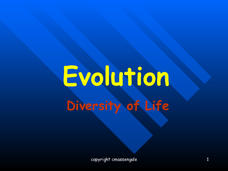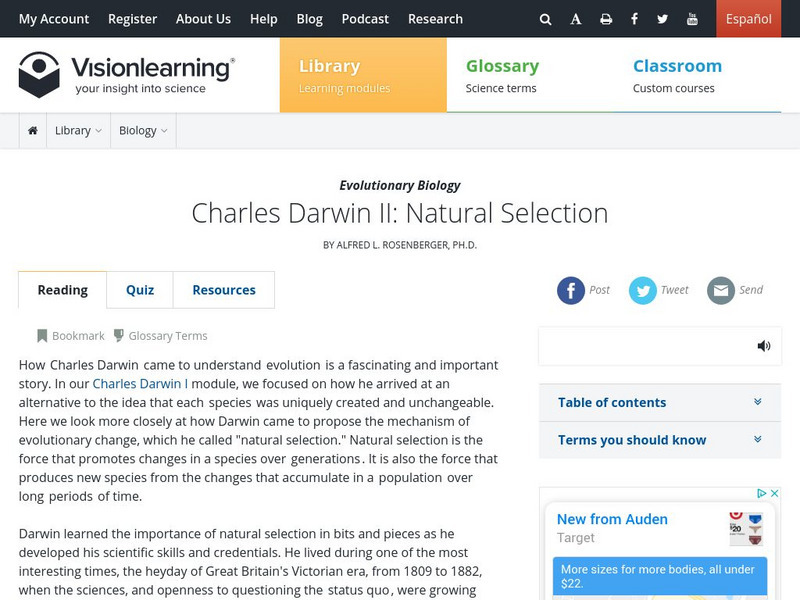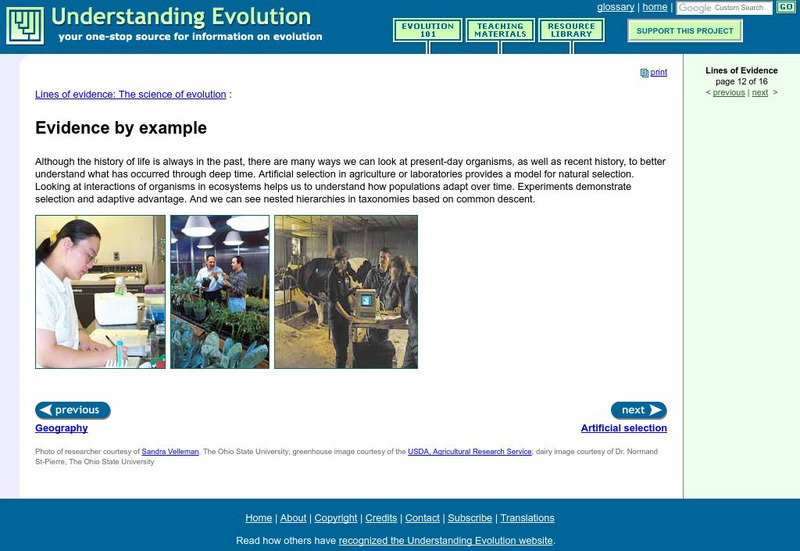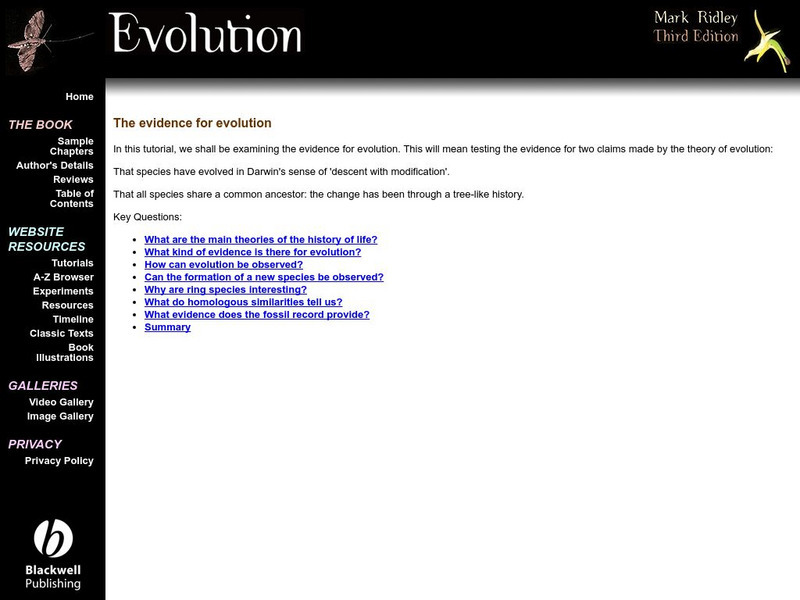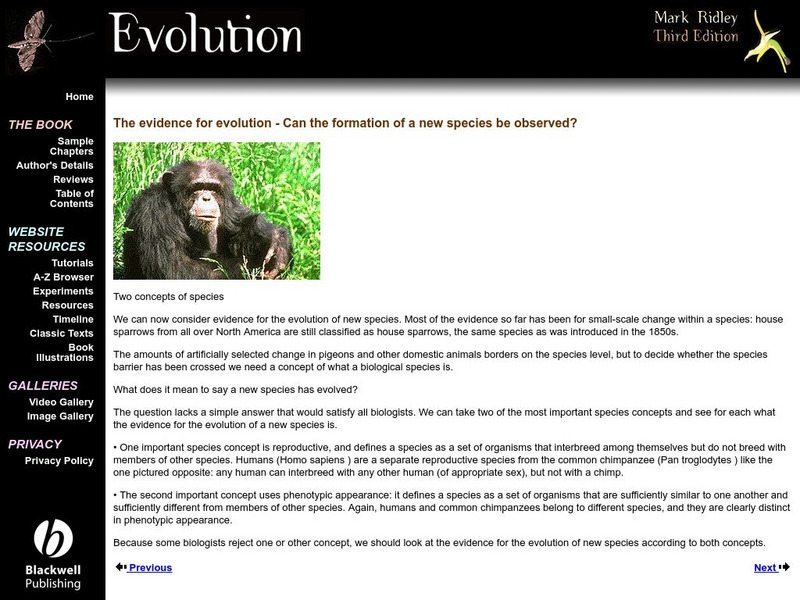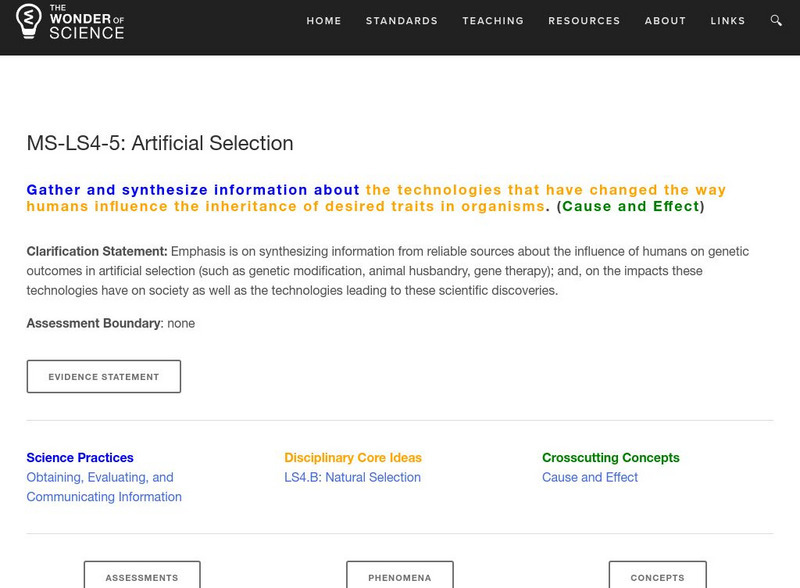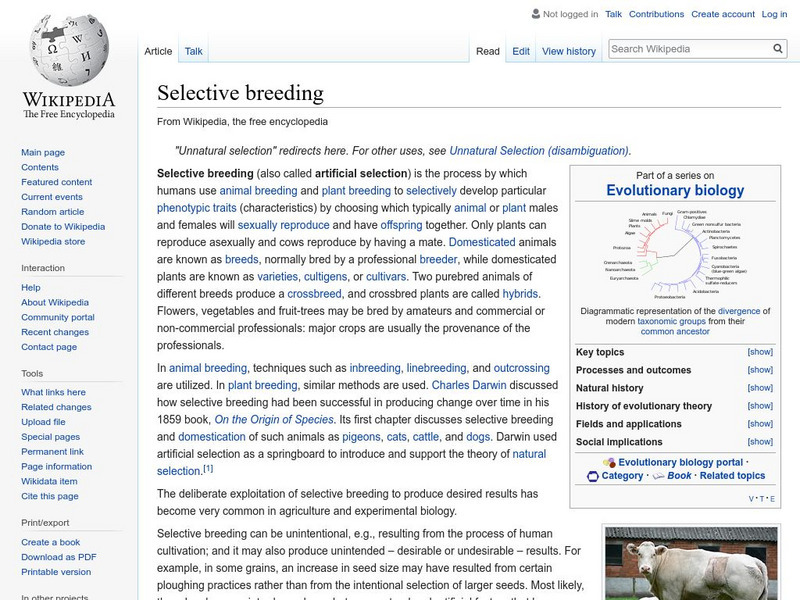Curated OER
Artificial Selection
The second lesson in the series begins with a starter activity discussing wild versus domesticated animals. Then, scholars play a card game, with optional variations, to emphasize artificial selection. Next, they attend a field trip to a...
University of California
Artificially Selecting Dogs
Selective breeding has resulted in some novel and beautiful or useful dogs over the years. Using the American Foxhound as an example, genetics learners find out how and why they came about. Then, in small groups, they select breeds to...
Biology Junction
Evolution – Diversity of Life
Scientists noticed animals with backbones share similar bone structure despite having different forms, such as fins, arms, and wings. Young scientists gain an appreciation for evolution by understanding the history of the theory. They...
Howard Hughes Medical Institute
Natural and Artificial Selection
Many people oppose genetically modified foods yet support selective breeding in dogs. Learn about the similarities and differences through a short presentation that features many video clips. It covers natural selection, artificial...
Curated OER
The Evidence for Evolution
Summarize a unit on evolutionary evidence. Learners recount information about the fossil record, molecular record, homologous structures, convergent evolution. This instructional activity provides plenty of room for learners to write out...
Compassion in World Farming Trust
Selective Breeding of Farm Animals
Biology learners read about selective breeding in chickens and how it has produced high-yield meat specimens and rapid egg-layers. The unpleasant effects of artificial selection are explored, as well as options to supporting this...
Curated OER
Evidence for Evolution
In this evidence of evolution worksheet, students review notes given by referring to the Nelson Biology text, chapter 11/13. Students read the notes and the specified pages in the text.
Other
Blackwell Publishing: Evolution: Adaptive Explanation
These pages are part of a site called Evolution that accompany a textbook by the same name. Mark Ridley is the author. There is a large amount of information available about adaptations and their role in evolution.
CK-12 Foundation
Ck 12: Episd: Influences on Darwin
[Free Registration/Login may be required to access all resource tools.] What did other scientists say about evolution? Check out this module to understand how Darwin developed his theory of evolution by natural selection and the ways...
Vision Learning
Visionlearning: Biology: Charles Darwin Ii: Natural Selection
Instructional module focusing on Charles Darwin's explanation of natural selection as the mechanism for evolution. Discusses how this force of natural selection promotes changes in species over time. Site also includes an interactive...
PBS
Pbs Learning Media: A Cow's Digestive System
Learn how a cow eats and digests food in this video segment from Nature.
Cold Spring Harbor Laboratory
Dna From the Beginning: Inheritance of Gene Variations
This animated description of George Shull's research of hybridization explains one of the key components of evolution, inheritance of gene variations.
Open Curriculum
Open Curriculum: Evolution Continues Today Can We Control It?
This article allows students to recognize that the process of evolution by natural selection continues to change our world and ourselves, both despite and because of our best efforts to control it.
PBS
Pbs: Pesticide Resistance
The chemical arsenal we have developed in an attempt to rid our homes of rodents and our crops of insects is losing its power. We have simply caused pest populations to evolve, unintentionally applying artificial selection in the form of...
University of California
University of California Museum of Paleontology: Evidence by Example
The Understanding Evolution website for teachers provides common examples of evolution, especially by artificial selection.
A-Z Animals
A Z Animals: Reference: Evolution
This entry identifies the defining characteritics of animal evolution, including adaptation, speciation, extinction, animal parternships and natural selection.
CK-12 Foundation
Ck 12: Biology: Influences on Darwin
[Free Registration/Login may be required to access all resource tools.] Discusses how early thinkers influenced Darwin's development of evolutionary theory.
CK-12 Foundation
Ck 12: Life Science: Origin of Species
[Free Registration/Login may be required to access all resource tools.] The creation of a new species is called speciation. Most new species develop naturally. But humans have also artificially created new breeds and species for...
Other
The Evidence for Evolution
These pages are part of a site called "Evolution," that accompanies a textbook by the same name. Mark Ridley is the author, and in this section he discusses the evidence for evolution.
Other
Evidence for Evolution: Formation of New Species
These pages are part of a site called Evolution that accompanies a textbook by the same name. Mark Ridley is the author. These pages offer an explanation of speciation using reproductive isolation and differences in phenotype.
The Wonder of Science
The Wonder of Science: Ms Ls4 5: Artificial Selection
Assessment templates, videos, examples, lesson plans, and photos of student work that directly address standard MS-LS4-5: artificial selection.
CK-12 Foundation
Ck 12: Earth Science: Theory of Evolution Study Guide
[Free Registration/Login may be required to access all resource tools.] This study guide looks at Darwin's theory of evolution and natural selection. It also looks at some of the evidence supporting the theory of evolution (comparative...
CK-12 Foundation
Ck 12: Life Science: 4.9 Origin of Species
Understand how species develop and change over time.
Wikimedia
Wikipedia: Selective Breeding
This entry from Wikipedia provides information on the selective breeding of animals and plants, along with a discussion of Darwinism.




